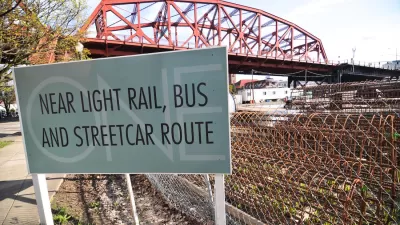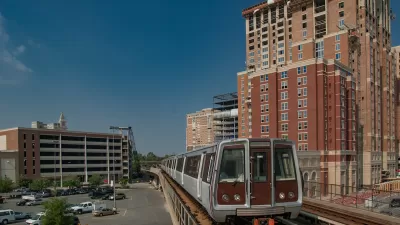As many planners know, building next to transit doesn't guarantee a project will have the ridership boosting effects envisioned by proponents of such developments. A new tool seeks to provide an objective measurement of TOD effectiveness.

"[P]lanners have invested decades of considerable work in the pursuit of transit-oriented development (TOD), under the presumption that clustering new housing, offices, and retail will result in rising transit use and, in turn, reduce pollution, cut down on congestion, and improve quality of life," writes Yonah Freemark. Yet, he continues, "what has been missing has been a tool that offers empirical insight into the benefits of specific development interventions in terms of their effect on growing transit use."
"To fill the gap, a new tool for measuring TOD quality has recently been introduced by the Institute for Transportation and Development Policy (ITDP). It holds potential value in terms of defining the appropriate measures for creating effective TOD, but it needs further development to be useful in aiding the creation of best-practice development designs."
Freemark tests the tool's effectiveness by applying it to three large TOD projects; and offers some insights into its potential benefits and current failings.
FULL STORY: Defining Clear Standards for Transit-Oriented Development

Coming Soon to Ohio: The Largest Agrivoltaic Farm in the US
The ambitious 6,000-acre project will combine an 800-watt solar farm with crop and livestock production.

Pennsylvania Mall Conversion Bill Passes House
If passed, the bill would promote the adaptive reuse of defunct commercial buildings.

U.S. Supreme Court: California's Impact Fees May Violate Takings Clause
A California property owner took El Dorado County to state court after paying a traffic impact fee he felt was exorbitant. He lost in trial court, appellate court, and the California Supreme Court denied review. Then the U.S. Supreme Court acted.

Divvy Introduces E-Bike Charging Docks
New, circular docks let e-bikes charge at stations, eliminating the need for frequent battery swaps.

How Freeway Projects Impact Climate Resilience
In addition to displacement and public health impacts, highway expansions can also make communities less resilient to flooding and other climate-related disasters.

California Grid Runs on 100% Renewable Energy for Over 9 Hours
The state’s energy grid was entirely powered by clean energy for some portion of the day on 37 out of the last 45 days.
City of Costa Mesa
Licking County
Barrett Planning Group LLC
HUD's Office of Policy Development and Research
Mpact Transit + Community
HUD's Office of Policy Development and Research
Tufts University, Department of Urban and Environmental Policy & Planning
City of Universal City TX
ULI Northwest Arkansas
Urban Design for Planners 1: Software Tools
This six-course series explores essential urban design concepts using open source software and equips planners with the tools they need to participate fully in the urban design process.
Planning for Universal Design
Learn the tools for implementing Universal Design in planning regulations.

























